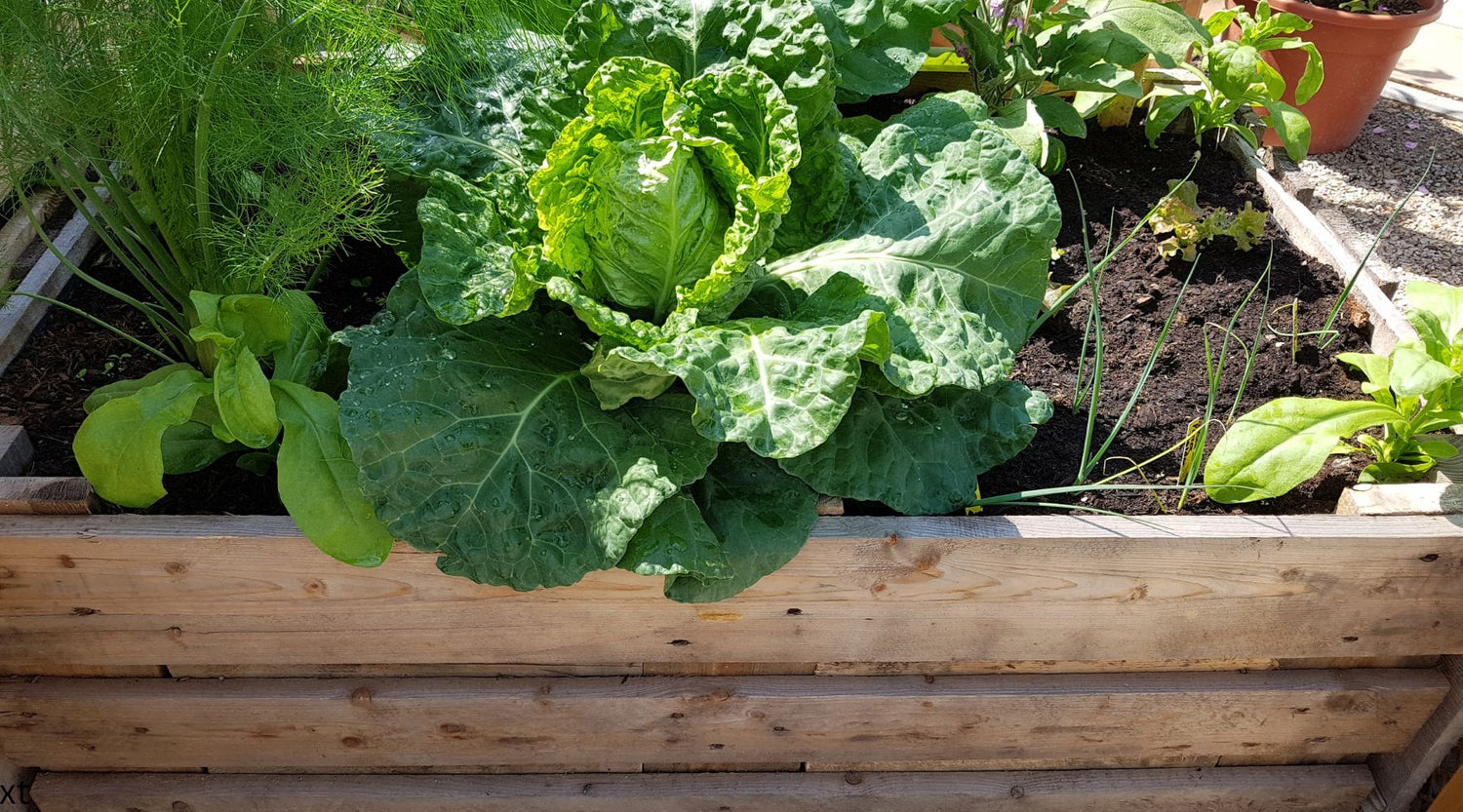So, you have decided to grow your own herbs and vegetables, maybe your tired of cold storage veggies on offer from the supermarkets and looking for the delicious taste and goodness of homegrown produce. Or you may want to save at the checkout and do you’re herb and veggie shopping from the back yard. Just for fun – you may also want to just get outdoors and engage in a rewarding and fulfilling experience of doing this yourself or with your kids.
Whatever your motive we are here to help guide you in the right direction. First on the agenda is what will your Raised Garden Bed be made from? from here we will take a look at what size garden bed is ideal for you along with where to place it in the garden.
What should your Raised Garden Bed be made from?

Wood was traditionally the go to for your raised garden beds, favoured amongst gardeners, for its cost-effectiveness and widespread accessibility. This has changed over the decades as we look for more sustainable options and timber prices have increased like most things. Wood, even when coated with a sealer becomes fragile under constant exposure to wind and rain and can develop mould and rot and need replacing over time. If your choosing timber, you need to check out the safety data of the timber you are using to make sure it’s safe for use as a garden bed You should be cautious of using second hand timber, it is critical to know the where the timber has been and how it’s been treated to avoid contaminating the soil.
Wood does have some advantages over other options. The obvious advantage of being very adaptable and flexible to the shape and design of your desired garden bed right down to the last millimetre. It also has remarkable thermal attributes compared to other materials.
PLASTIC
Plastic has come along way from PVC products which leach chemicals into the soil, with many recycled plastic beds being safe to use and great for the environment, but always check the safety and suitability of your chosen product.
Many of the plastic options on the market are smaller in size and ideal when only a small growing space is required. Advantages here are they are easy to move around as required, usually designed with legs and wheels so you can take advantage of the sun as needed and move into the shade on those hot days. They are also at the perfect working height, making them a great choice for seniors or those with mobility issues. Generally, budget-friendly and the durable nature of plastic make it a good material for raised garden beds.
There are some composite timber look recycled materials to build larger garden beds to that are easy to maintain and eco-friendly. Again, no chemicals will leach into the garden beds, but they do come at an increased cost.
GALVANISED METAL
Aluminium Zinc is a great choice, offering a range of advantages over traditional wooden or plastic beds although more expensive than wood they will last for many years with minimal maintenance. Aluminium Zinc is highly resistant to rust and corrosion, making these beds suitable for outdoor use and ensuring they will not fade over time. The Zinc coating is also entirely food safe, giving you peace of mind that nothing toxic is seeping into the soil. Colourbond steel is pre-painted to provide colour options, but still has zincalume core so is equally suitable.
Another significant advantage of the Aluminium Zinc Beds is they are made from galvanised 22-guage steel, which is both lightweight and strong. This material is known to last 4-7 times longer than standard wooden beds, making them a durable option for those looking for a long-term solution.
Galvanised raised garden beds have a visual charm of their own. The metal boasts a silver lustre that has the potential to lend a chic and contemporary aura to your outdoor area, or opt for a colorbond option to match your decor. Furthermore, its effortless cleanliness and upkeep contribute to its suitability for enhancing the aesthetics of your garden.
The widespread appeal of galvanized garden beds stems from their incredible flexibility. People love how simple they are to work with and the countless options for their veggie space. You can set up galvanized beds on almost any surface you can think of, whether it's in a garden bed, on lawn, pavers or cement. No more fretting about tearing up vast stretches of your yard for a garden. With galvanized beds, all you need to do is pick your spot, and you're ready to dig in and start planting!
What size and where?

WHAT SIZE:
Choosing the right size for a garden bed is a crucial decision for any aspiring gardener, as it directly impacts the success and productivity of your garden. The size of your garden bed should be determined by several factors, including your available space, gardening goals, your health and your level of commitment and effort.
First and foremost, consider the available space you have in your yard or garden area. Smaller spaces may need careful planning to work out the best fit for your raised garden beds to maximize the use of limited square footage. Think about your gardening goals. Are you looking to grow a few herbs and vegetables for personal consumption, or do you aspire to have a bountiful, self-sustaining garden? For beginners or those with limited time, starting with smaller beds is often recommended, as they are more manageable and require less maintenance. As your gardening skills and experience grow, you can gradually expand the size of your garden beds to meet your increasing needs and ambitions.
The height of the raised garden bed is your next decision and first and foremost should be your physical ability. If you’re a fit keen gardener, then bending down to tend a low raised garden bed will not be a problem. You have the added advantage of being able to save on soil as the low beds obviously taking much less filling. There are many low raised garden beds available. If you’re looking to keep your kitchen stocked with home grown fresh herbs and vegetables, then a low garden bed of around 400mm such as the Birdies Original Veggie Bed will be perfect for you. Any raised bed should be tall enough to accommodate the full root ball of whatever plants you're growing. Our raised garden beds with a depth of 400mm are deep enough to grow pretty much any kitchen garden vegetable or herb.
If like many of us you are ageing gracefully and need to preserve your well-being, opting for a higher raised garden bed will save on many sore knees and backaches to come. Whilst the fill cost will be more, you can’t put a price on your health. The high raised garden beds are also chosen for a great look, they stand out more than the lower beds and provide a nice visual when looking out on your garden. They can also be used as a screen planting against unsightly fences or strategically placing your beds to bring defined section to your backyard. Ideal for small backyards that have limited space to bring colour and life to your courtyard without the fuss of messy garden beds.
WHERE:
One of the main advantages of raised garden beds is that they required no ground preparation and the site for the bed generally does not need to be level. This makes it easy to set up your garden bed quickly and get started with planting right away. Here's our checklist of things to consider when choosing a spot for your raised garden bed.
- Concrete or Pavers: When it comes to creating raised garden beds, you have the flexibility to install them on a variety of surfaces, including paved patios and concrete driveways. To ensure optimal performance, we recommend incorporating a geotextile membrane drain mat fabric at the base of the bed. This not only prevents soil erosion but also serves as a filtration layer to enhance drainage.
- Lawn: for those looking to add colour or transform a lawn area into a vegetable garden spot, you can easily position your raised garden bed on the existing lawn with some preparation. Start by marking out the designated area for your bed and apply glyphosate to the patch of grass you plan to convert. Allow a few days for the grass to begin wilting before placing your new bed in its intended location. A layer of weed matting is also recommended for both lawns and garden beds where the area has been prone to weed growth.
- Slopes: When dealing with slopes, a gentle incline is acceptable. It is advisable to orient the raised garden bed lengthwise along the slope. If you choose to position it across the slope, place starting pickets against the inside of the bed and secure them by either bolting them to the bed or positioning them on the outside, with a spacing of 1 meter between them.
- Sunlight: One of the most important considerations when situating your raised garden bed is the amount of sunlight it will be exposed to. In Perth, the climate is typically characterized by high temperatures and arid conditions, necessitating an ample supply of sunlight for plant growth. When selecting a placement for your raised bed, seek out a location that enjoys a minimum of six hours of direct sunlight daily. It's essential to steer clear of areas shaded by trees or structures, as they won't offer the necessary light for your plants. Furthermore, avoid positioning raised garden beds beneath trees or in areas where tree roots might disrupt your plants' growth.
- Water: Perth's reputation for its extended, scorching summers poses a challenge for plant growth. It's crucial to position your raised garden bed in close proximity to a water source for convenient and regular plant watering. If your bed happens to be distant from such a source, you might have to consider installing an irrigation system to guarantee your plants receive the necessary hydration.
- Wind: Perth is prone to windy conditions that can harm plants. When selecting a spot for your raised garden bed, seek out a location shielded from powerful winds. If such a sheltered area isn't readily available, contemplate setting up a windbreak to safeguard your plants. Options like lattice or shade cloth can serve as effective wind barriers.
- Access: Last but not least, take into account the ease of reaching your raised garden bed. Opt for a location that allows effortless access for planting, watering, and harvesting. Steer clear of spots that demand strenuous bending and kneeling or are challenging to reach. If your focus is growing fresh herbs and vegetables, place your garden bed close to the kitchen for easy access and to keep a visual focus on what’s ready for eating.
By taking these factors into account, you can ensure your plants have the best chance of thriving in your raised garden bed. Take a look at our complete range of garden beds and find you perfect raised garden bed.






